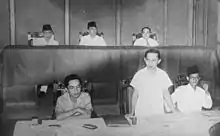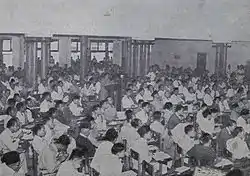Central Indonesian National Committee
The Central Indonesian National Committee (Indonesian: Komite Nasional Indonesia Pusat) or KNIP, was a body appointed to assist the president of the newly independent Indonesia. Originally purely advisory, it later gained assumed legislative functions. The Working Committee of the KNIP became part of the People's Representative Council when Indonesia became a unitary state in 1950.[1]
Central Indonesian National Committee Komite Nasional Indonesia Pusat | |
|---|---|
| Type | |
| Type | |
| History | |
| Founded | August 29, 1945 |
| Disbanded | December 15, 1949 |
| Leadership | |
Chairman | |
| Meeting place | |
 | |
Part of a series on the |
|---|
| History of Indonesia |
   |
| Timeline |
|
|
Pre-independence bodies
The Japanese invaded Indonesia in 1942. By 1943 the tide had turned against them, and in order to encourage support for the war effort, the Japanese appointed Indonesian advisors (sanyo) to the administration and appointed nationalist leader Sukarno leader of a new Central Advisory Board (Chuo Sani-kai) in Jakarta.[2] In March 1945, the Japanese established the Investigating Committee for Preparatory Work for Independence (Indonesian: Badan Penyelidik Usaha Persiapan Kemerdekaan) or BPUPK, chaired by Radjiman Wediodiningrat, with Sukarno, Hatta and Thamrin among its members. This body drew up a constitution for an independent Indonesia over several weeks of meetings. At a session of the Committee on 1 June 1945, Sukarno laid down the principles of Pancasila, which would become the Indonesian national ideology.[3][4]
On 7 August, the day after the atomic bombing of Hiroshima, the Preparatory Committee for Indonesian Independence (PPKI) was established. Sukarno was chairman, and Hatta vice-chairman.
Establishment
On 17 August, Sukarno proclaimed the Independence of Indonesia.[5] On 18 August, the PPKI accepted the constitution drawn up by the BPUPK as the provisional Constitution of Indonesia and decided that during a six-month transition period, the new republic would be governed according to the constitution by a president, assisted by a National Committee, who would establish the two chamber legislature mandated by the constitution. The upper chamber, the People's Consultative Assembly would then have six months to draw up a new constitution, leaving open the possibility that this would be an entirely new document free of the influence of the situation prevailing during the Second World War.[4] The PPKI also named Sukarno as president and Hatta vice-president.[6] The following day it appointed 12 government ministers and decreed that Indonesia was to be divided into eight provinces.[7]
On 29 August, Sukarno dissolved the Preparatory Committee for Indonesian Independence and established the Central Indonesian National Committee (KNIP). Sukarno and Hatta appointed 135 members, including the membership of the PPKI to this new body. It included people representing areas outside Java, Islam, women and young people.[8][9]
The KNIP as legislature

Following pressure by individuals including Sutan Sjahrir and Amir Sjarifuddin for a less authoritarian system of government, on 16 October, Vice-president Hatta issued Vice-Presidential Edict No.X transferring the powers the Constitution conferred on the People's Consultative Assembly and People's Representative Council from the president to the KNIP, making the government more parliamentary in nature. The day-to-day tasks of the KNIP would be carried out by a Working Committee. On 30 October, a decree allowed the establishment of political parties. Then on 11 November, Sukarno accepted the fact that ministers would now be responsible to parliament, rather than to him. Three days later, Sutan Syahrir became Indonesia's first prime minister.[10][11][12]
In July 1946, the KNIP was reorganized by government decree. It now had 200 members. Of these, 110 were elected, 60 represented organizations and 30 were nominated by the president. Meanwhile, hopes that national elections would be held in January 1946 as planned began to fade.
At the end of 1946, there was "manipulation" of the KNIP membership when it appeared likely the body would reject the Linggadjati Agreement between the Dutch and the Indonesian republicans. In order to avoid this rejection, Sukarno more than doubled the size of the KNIP to 514 members. The decision to expand the KNIP was taken in late 1946, but became effective only in March 1947. The number of left-wing members increased sharply as they wanted the Dutch military action to be ended as quickly as possible. These changes severely damaged that the KNIP's image as representing public opinion.[11][13][14]
Because of the ongoing armed struggle against the Dutch, it was not possible for the entire KNIP to meet regularly. Therefore, the KNIP acted as the upper house, the People's Consultative Assembly in the constitution, meeting only infrequently to discuss fundamental and pressing national issues, while the Working Committee continued to act as the day-to-day parliament.[15]
Membership
After the Linggadjati Agreement was signed between the Republic of Indonesia and the Dutch in November 1946, the left-wing parties, who supported the agreement, formed the Left Wing grouping, while parties opposing it formed the Republican Fortress. The proportion of seats held by the Left Wing increased dramatically following President Sukarno's appointments. The original and revised membership was as follows:[14][16]
| Affiliation | 1946 | 1947 |
|---|---|---|
| Socialist Party (PSI) | 35 | 35 |
| Communist Party of Indonesia (PKI) | 2 | 35 |
| Labour Party of Indonesia | 6 | 35 |
| Workers | - | 40 |
| Peasants | - | 40 |
| Parkindo | 4 | 8 |
| Catholic Party | 2 | 4 |
| Left Wing (Sayap Kiri) | 49 | 197 |
| Masjumi | 35 | 60 |
| Indonesian National Party (PNI) | 45 | 45 |
| Republican Fortress (Benteng Republik) | 80 | 105 |
| Sumatra | 1 | 50 |
| Kalimantan | 4 | 8 |
| Sulawesi | 5 | 10 |
| Moluccas | 2 | 5 |
| Lesser Sundas | 2 | 5 |
| Chinese | 5 | 7 |
| Arabs | 2 | 3 |
| Eurasian | 1 | 3 |
| Other categories | 49 | 121 |
| Various allegiances | 71 | 212 |
| TOTAL | 200 | 514 |
KNIP sessions
The KNIP held six sessions between 1945 and 1949 in various locations around Java.[17]
| Session | Dates | Location | Notes |
|---|---|---|---|
| I | 29 August 1945 | Former Schouwburg Weltevreden theater, Jakarta | Members inaugurated by Sukarno |
| II | 16–17 October 1945 | Hotel Binnenhof, Jakarta | |
| III | 25–27 November 1945 | Jl. Diponegoro, Jakarta | |
| IV | 28 February – 3 March 1946 | Solo, Central Java | |
| V | 25 February – 6 March 1947 | Societet Concordia building, Malang | Ratified the Linggadjati Agreement[18] |
| VI | 5–15 December 1949 | Indonesian Red Cross building, Yogyakarta |
Dissolution
Following the transfer of sovereignty to the United States of Indonesia (RIS), in December 1949, the state adopted a bicameral system. The KNIP met for the last time on 15 December 1949 to agree to the Republic of Indonesia joining the RIS. However, this state was short lived, and when Indonesia became a unitary state in August 1950, the Working Committee of the KNIP became part of the People's Representative Council.[1][19]
Notes
- Kahin 1952, p. 464.
- Ricklefs 2008, p. 183.
- Ricklefs 2008, p. 197.
- Cribb 2001, p. 272.
- Ricklefs 2008, pp. 197-198.
- Kahin 1952, p. 138.
- Simanjuntak 2003, p. 16.
- Kahin 1952, pp. 139-140.
- Cribb 2001, p. 274.
- Kahin 1952, pp. 151-152.
- Cribb 2001, p. 276.
- Ricklefs 2008, p. 206.
- Rose 1959, p. 148.
- Cribb & Kahin 2004, pp. 489-490.
- Cribb 2001, pp. 280-281.
- Reid 1974, pp. 96-97.
- Tim Penyusun 1970, pp. 7-10, 460-461.
- Kahin 1952, pp. 199-206.
- Cribb 2001, p. 284.
References
- Cribb, Robert; Kahin, Audrey (2004). Historical Dictionary of Indonesia. Scarecrow Press. ISBN 9780810849358.
- Cribb, Robert (2001). "Parlemen Indonesia 1945-1959 (Indonesian Parliaments 1945-1959)". In Yayasan API (ed.). Panduan Parlemen Indonesia (Indonesian Parliamentary Guide) (in Indonesian). Yayasan API. pp. 97–113. ISBN 979-96532-1-5.
- Kahin, George McTurnan (1952). Nationalism and Revolution in Indonesia. Ithaca, New York: Cornell University Press.
- Reid, Anthony J.S. (1974). Indonesian National Revolution 1945-50. Hawthorn: Longman Australia. ISBN 0-582-71047-2.
- Ricklefs, M. C. (2008) [1981]. A History of Modern Indonesia Since c. 1300 (4th ed.). London: Palgrave Macmillan. ISBN 978-0-230-54685-1.
- Saul, Rose (1959). Socialism in Southern Asia. London: Oxford University Press.
- Simanjuntak, M. C. (2003). Kabinet-Kabinet Republik Indonesia: Dari Awal Kemerdekaan Sampai Reformasi (Cabinets of the Republic of Indonesia: From the Start of Independence to the Reform Era) (in Indonesian). Jakarta: Penerbit Djambatan. ISBN 979-428-499-8.
- Tim Penyusun Sejarah (1970), Seperempat Abad Dewan Perwakilan Rakyat Republik Indonesia [A Quarter Century of the People's Representative Council of the Republic of Indonesia] (PDF) (in Indonesian), Jakarta: Sekretariat DPR-GR
